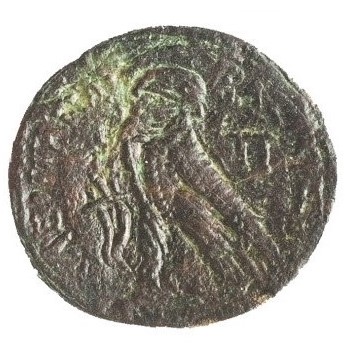Title: 80-drachma piece of Kleopatra (Cleopatra) VII of Egypt - 1976.01
Acquisition number: 1976.01
Author or editor: Douglas Kelly
Culture or period: Ptolemaic Egypt/Hellenistic.
Date: 44 - 30 BC.
Material: Metal - Bronze
Object type: Coins - Greek
Dimensions: 27mm (w)
Origin region or location: Egypt
Origin city: Alexandria
Display case or on loan: 5
Keywords: Coin, Greek, Egypt, Egyptian, Alexandria, Kleopatra, Cleopatra, drachma, Caesarion, Ptolemy XIV, Octavian, Actium
Sylloge Nummorum Graecorum, Copenhagen, The Royal Collection of Coins and Medals, Danish National Museum, repr. edn (West Milford, NJ, 1981-), 419-21.
D.R. Sear, Greek Coins and their Values, vol. 1, Europe (London, Seaby, 1978), 7955.
C. Howgego, Ancient History from Coins (London and New York, Routledge, 1995), 52-54, 132.
O. Mørkholm (P. Grierson and U. Westermark, eds), Early Hellenistic Coinage from the Succession of Alexander to the Peace of Apamea (336-186 BC) (Cambridge, Cambridge University Press, 1991), 101-111, 183-184.
R. S. Poole, Catalogue of Greek Coins: The Ptolemies, Kings of Egypt (London, The British Museum, 1883), 123 no. 4 and Plate XXX no. 7.
1976.01
80-drachma piece of Kleopatra (Cleopatra) VII of Egypt
Bronze 18.14 g. 27 mm. 44-30 BC.
Obv.: Bust of Kleopatra (Cleopatra) r., diademed.
Rev.: Eagles standing l. on thunderbolt. To the left, double cornucopiae. To the right, Π. ΚΛΕΟΠΑΤΡΑΣ [BA]ΣΙΛΙΣΣΗΣ (‘of Queen Kleopatra’), which runs around the upper circumference of the field.
This coin comes from the mint at Alexandria. The double cornucopiae indicate a period of co-regency, i.e., between 44 BC (when Kleopatra’s younger brother, Ptolemy XIV, died and she took as co-regent her three-year-old son Ptolemy XV Caesarion) and 30 BC (when Kleopatra suicided, following Octavian’s victory at Actium and his invasion of Egypt). The reverse states that it is a coin ‘of Queen Kleopatra’. The eagle is a traditional reverse type of Ptolemaic coins.
Like other Eastern rulers for many centuries before her, Kleopatra put her own portrait on her coins. Romans did not put heads of living persons on their coins until Julius Caesar, c. 44 BC, initiated a change of practice. Kleopatra’s coins are the last Hellenistic royal coins from Egypt. Roman coins replaced hers.
Any coin of Kleopatra VII will attract attention because of fascination with her appearance and personality. The coin here is important also for the light it shines on the economic and monetary policy of Ptolemaic Egypt. The drachma units of this bronze coin refer to the weight of the coin not the denomination.
Egypt possessed abundant gold and copper but hardly any silver. Ptolemaic coinage included only a small proportion of silver, which becomes increasingly rare after c. 200 BC. By contrast, the size, weight and variety of copper/bronze coinage shows there was no shortage of this metal.
Egypt was self-contained geographically. From the times of the Pharaohs it had inherited a degree of centralized control not found elsewhere in the Mediterranean world. State control of much of the economy extended to money matters. By 267/66 BC a decree was in force requiring all foreign gold coinage brought into the kingdom to be exchanged for Ptolemaic coins. Foreign silver coins have been rarely found in Ptolemaic Egypt and Ptolemaic silver had limited circulation abroad in places subject to Ptolemaic control or intervention. This was very probably due to strict government control of silver.
For practical purposes, Ptolemaic Egypt had a bimetal currency system of gold and copper/bronze. By c. 210 BC, following state directives, the copper/bronze drachma was used as the standard unit of reckoning in place of the silver drachma in account-keeping and tax assessment. There was no one-drachma copper/bronze coin, the smallest copper/bronze denomination being a five-drachma piece.
The ratio of copper/bronze to silver in drachmas increased over time from the original 120:1. The Greek letters Π and Μ appearing on two types of the copper/bronze coins of Kleopatra VII are key evidence for the ratio of copper/bronze to silver being 480:1. They indicate that these coins were worth 80 (Π) and 40 (Μ) respectively of the copper/bronze drachmas that were then equivalent (on papyrus, so to speak) to a silver drachma. The Π coins were each the equivalent of an obol (one-sixth of a drachma) and the Μ coins of a half-obol.
Sylloge Nummorum Graecorum, Copenhagen, The Royal Collection of Coins and Medals, Danish National Museum, repr. edn (West Milford, NJ, 1981-), 419-21.
D.R. Sear, Greek Coins and their Values, vol. 1, Europe (London, Seaby, 1978), 7955.
C. Howgego, Ancient History from Coins (London and New York, Routledge, 1995), 52-54, 132.
O. Mørkholm (P. Grierson and U. Westermark, eds), Early Hellenistic Coinage from the Succession of Alexander to the Peace of Apamea (336-186 BC) (Cambridge, Cambridge University Press, 1991), 101-111, 183-184.
R. S. Poole, Catalogue of Greek Coins: The Ptolemies, Kings of Egypt (London, The British Museum, 1883), 123 no. 4 and Plate XXX no. 7.

